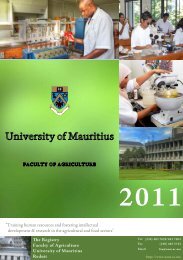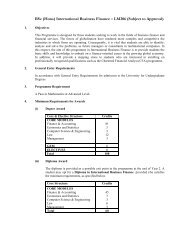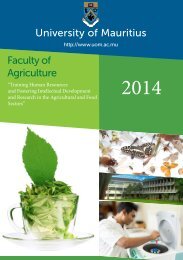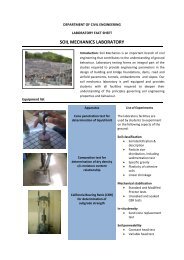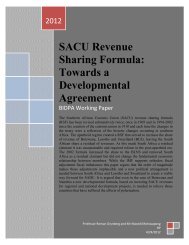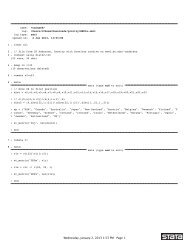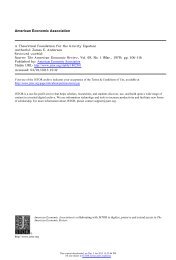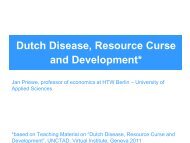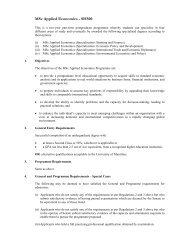Capital Formation and Economic Growth in Mauritius
Capital Formation and Economic Growth in Mauritius
Capital Formation and Economic Growth in Mauritius
You also want an ePaper? Increase the reach of your titles
YUMPU automatically turns print PDFs into web optimized ePapers that Google loves.
<strong>Capital</strong> <strong>Formation</strong> <strong>and</strong> <strong>Economic</strong> <strong>Growth</strong> <strong>in</strong> <strong>Mauritius</strong>: Does FDI matter?ICITI 2012 ISSN: 16941225(i) Impact of capital formation on growthIn the ARDL bounds test<strong>in</strong>g approach, the first step is to specify the short-run effects <strong>in</strong> ECMformat so as to establish existence of long-run relationship among variables. Thus, equation [5]is transformed <strong>in</strong>to [6] as:rgdpcqgii 1tfdit0i1rgdpcqzii 1zt 1t it2privt 13pubt 14fdit 1z5 t 1pq fkrgdpct1k 1 i 1iprivtiq pi 1i[6]pubtiIn the above ARDL-ECM equation represents the drift parameter, <strong>and</strong>jare the long- <strong>and</strong>short-run multipliers, <strong>and</strong>are white noise error terms. The equation is similar to those of Engle<strong>and</strong> Granger (1987), except that it comprises a l<strong>in</strong>ear comb<strong>in</strong>ation of the lagged level variables <strong>in</strong>place of the lagged error-correction term. Follow<strong>in</strong>g Pesaran et al. (2001), co<strong>in</strong>tegration can beexpected if the long-run coefficients of all lagged level variables are jo<strong>in</strong>tly significant (i.e.values of, for i = 1,..,4). The ARDL-ECM equation is estimated <strong>and</strong> the F-test is carriedout to test the null hypothesis of no co<strong>in</strong>tegration. 12H 0: λ 1 = λ 2 =λ 3 = λ 4 = λ 5 = 0H 1 : λ 1 ≠ λ 2 ≠ λ 3 ≠ λ 4 ≠ λ 5 ≠ 0Note, the F-test follows an asymptotic non-st<strong>and</strong>ard distribution <strong>and</strong> the critical F-values areobta<strong>in</strong>ed from Pesaran et al. (2001). The test generates two asymptotic critical valuesrepresent<strong>in</strong>g the lower <strong>and</strong> the upper bounds. The two asymptotic critical bounds provide a testfor co<strong>in</strong>tegration when the <strong>in</strong>dependent variables are I(d), if <strong>and</strong> only if 0 ≤ d ≤ 1. Table 2.9compares the computed F-statistics of the model with the bounds, the f<strong>in</strong>d<strong>in</strong>gs confirms that thecomputed F-statistics is greater than the upper bound critical value at 1% significance level, the12 Accord<strong>in</strong>g to Pesaran et al. (1997), OLS coefficients of first differences are of no direct <strong>in</strong>terest to the boundsco<strong>in</strong>tegration test.19




